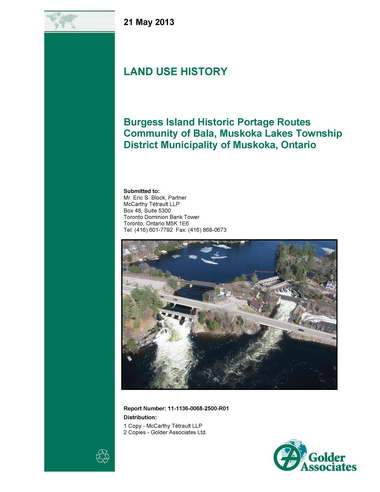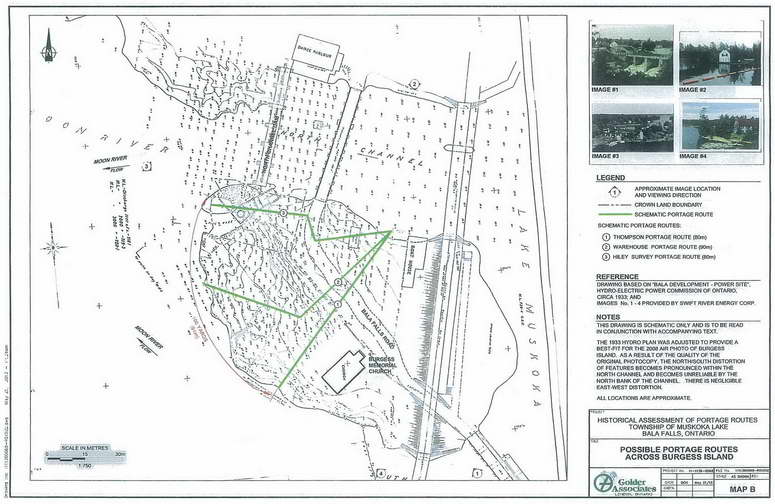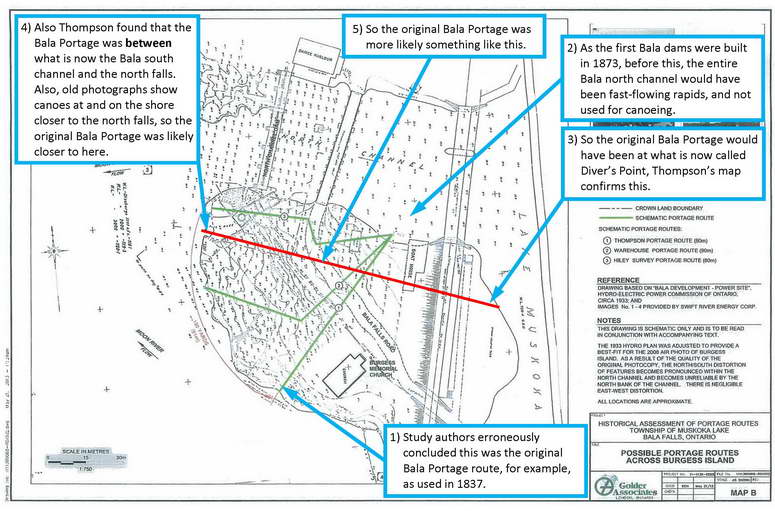Summary
- After years of the proponent and the Ontario Ministry of Natural Resources referring to the Bala Portage as the “alleged portage” or the “purported portage”, we find that the proponent’s own study confirms that the traditional and historic Bala Portage has always been south of the Bala north falls.
- However, the study’s authors conclude an incorrect route for the original Bala Portage.
- But the important point is that the Bala Portage has always been south of what is now called the Bala north falls, and that due to the provincial government’s actions (their construction of the highway bypass in 1965), the only available route for the Bala Portage now is over the Crown land, which would be obstructed by the proponent’s current Alternative 1A plans.
Detail
For the Township of Muskoka Lakes’ 2013 Judicial Review hearing, the proponent commissioned a study to determine the location of the original Bala Portage. The study found that the exact route of the Bala Portage would have changed over time, for example, due to the construction of the railway in 1907 and of the highway bypass in 1965.
This 98-page study was written by two well-respected Ph.D.s, and can be viewed by clicking on the image below (it is a 6 Mbyte file, so will take some time to download).
After years of the proponent and the Ontario Ministry of Natural Resources referring to the Bala Portage as the “alleged portage” or the “purported portage” and denying its existence, we find in this study that the proponent themselves confirm that the Bala Portage has always been south of the Bala north falls.
The study concludes that over time, there were three different portage routes south of the Bala north falls, as shown by the green linies in their Map B (reproduced below, click on it for a larger view, which includes added comments).
As summarized in our commented version of their Map B, the study’s authors erred in their determining the exact route of the original Bala Portage, as follows:
- The Bala dams were first built in 1873. Before this, the full length of the Bala north channel would have been a fast-flowing rapids, definately not suitable for canoeing. So the original Bala Portage would not have ended in the Bala north channel, instead it would have ended at what is now called Diver’s Point. This is confirmed by cartographer and explorer David Thompson’s own 1837 map, the relevant section is here.
- The proponent’s study carefully recites the relevant sections of Thompson’s journal as included in Mitchell Shnier’s letter to the Ministy of the Environment (bottom of page 8) and in his Affidavit (paragraphs 28 to 30). But inexplicably, the proponent’s study ignores Thompson’s subsequent sentence where after camping the night, Thompson finds that the Bala Portage is actually not the Bala south channel, but is between the Bala north falls and the Bala south channel.
Therefore, rather than the proponent’s study’s conclusion that the original Bala Portage’s route was the green line with the ➀, the original Bala Portage was more likely the red line as shown in the marked-up Map B. This is confirmed by the photographs in this article, which all show canoes at and on the shore, directly south of the Bala north falls.
In any case, it is clear that the Bala Portage has always been south of the Bala north falls.
Conclusion
- The proponent’s own study confirms that the traditional and historic Bala Portage has always been south of the Bala north falls.
- The study authors failed to use all the information available to them and as a result erred in the exact route of the original Bala Portage.
- Due to the provincial government’s actions (their construction of the highway bypass in 1965), the only available route for the Bala Portage now is over the Crown land, which would be obstructed by the proponent’s current Alternative 1A plans.


